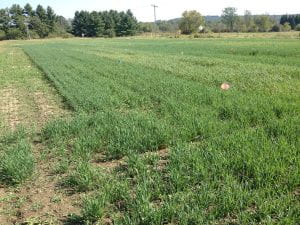By mid-August the options for boosting forage inventory are limited. A winter small grain (rye, triticale, or wheat) can be planted immediately after corn silage harvest for early spring forage harvest.
A second option is to plant oats as soon as possible for fall harvest or grazing. According to the Wisconsin Team Forage fact sheet Fall-Grown Oat Forages, a heavy seeding rate of 3 bu/ac fertilized with 40 pounds of nitrogen is recommended to maximize fall forage production. In general, forage oats will mature more slowly than a grain oat, extending the fall growth window as long as the weather cooperates. The forage oats are the recommended type for planting from mid-July through the first week of August. When planting after the first week of August, it is recommended that “earlier–maturing, grain-type cultivars will provide greater forage yields than ForagePlus or other forage-type cultivars.” The authors explain, “this occurs because the time interval between planting and the onset of winter weather is relatively short, and the slower maturation characteristics of forage-type cultivars become an increasing liability relative to faster-maturing, grain-type cultivars.”
For more information, see the following fact sheets:
- Fall-Grown Oat Forages: Cultivars, Planting Dates, and Expected Yields, University of Wisconsin Team Forage
- Grazing Management for Fall-Grown Oat Forages, University of Wisconsin Team Forage
- Emergency and Alternative Summer Annual Forages, Cornell University Nutrient Management Spear Program
- Winter Triticale Forage, Cornell University Nutrient Management Spear Program

